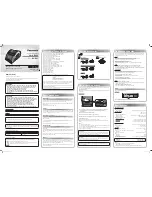
Reference
RLX-FHE, RLX-FHES, RLX-FHS
♦
RadioLinx FH
Frequency-Hopping Industrial Radio
ProSoft Technology, Inc.
Page 135 of 151
November 25, 2008
MIC:
Message Integrity Check. One of the elements added to the TKIP standard.
A "signature" is added by each radio on each packet it transmits. The signature is
based on the data in the packet, a 64-bit value (key) and the MAC address of the
sender. The MIC allows the receiving radio to verify (check) that the data is not
forged.
MIMO:
Multiple Input Multiple Output refers to using multiple antennas in a WiFi
device to improve performance and throughput. MIMO technology takes
advantage of a characteristic called multipath, which occurs when a radio
transmission starts out at Point A and the reflects off or passes through surfaces
or objects before arriving, via multiple paths, at Point B. MIMO technology uses
multiple antennas to collect and organize signals arriving via these paths.
Modbus:
The ModBus protocol provides the internal standard that the
MODICON controllers use for parsing messages. During communications on a
ModBus network, the protocol determines how each controller will know its
device address, recognize a message addressed to it, determine the kind of
action to be taken, and extract any data or other information contained in the
message. If a reply is required, the controller will construct the reply message
and send it using ModBus protocol.
modem:
Stands for MODulator-DEModulator, a device that converts digital
signals to analog signals and vice-versa. Analog signals can be transmitted over
communications links such as telephone lines.
null modem cable:
A specialty cross-communication cable with female
connectors on each end used for direct connection between devices when no
modems are present. Commonly used as a quick and inexpensive way to
transfer files between two PCs without installing a dedicated network card in
each PC.
Panel Antenna:
An antenna type that radiates in only a specific direction. Panel
antennas are commonly used for point-to-point situations. Sometimes called
Patch antennas.
Parabolic Antenna:
An antenna type that radiates a very narrow beam in a
specific direction. Parabolic antennas offer the highest gain for long-range point-
to-point situations.
Peer-to-Peer Network:
Each radio in a Peer-to-Peer network has the ability to
receive data from - and transmit data to - any other radio in the network.
Point-Multipoint (Broadcast) Network:
A network type where a single master
radio sends data to every remote radio in the network. This is done repeatedly
until every remote radio individually receives and acknowledges the data. Each
remote radio sends pending data to the master radio that receives and
acknowledges data sent from each remote. In this configuration, there are
multiple remote radios referenced to a single master radio.
Summary of Contents for RadioLinx FH Series
Page 6: ......
















































